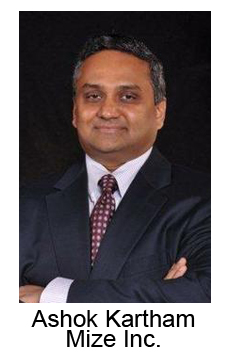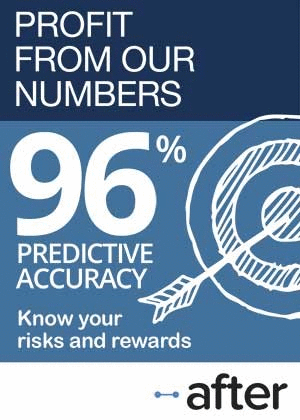Extended Warranty Software:Unlike most other solutions, which are designed to integrate with passenger car dealer management systems or retail point of sale software, the new Mize offering is aimed at manufacturers engaged in the business-to-business sale of commercial service contracts.
This week, Mize Inc. released the latest version of its Service Contracts Management solution at the Extended Warranty & Service Contract Innovations Conference in Nashville.
Ashok Kartham, the founder and CEO of Mize, said this is the formal launch of some capabilities that have already been in use by several Mize clients, as well as the company's formal entrance into the service contract software platform business.

"We have been working in the service contract industry for some time," Kartham said. "Previous releases of the product are already in use. Here, we are releasing what we are calling a next-generation service contract solution," which he said is a combination of new functionality and new packaging.
Kartham said this new release of the service contract solution has more functionality built into the standard configuration, which reduces the price from what it would be if the modules for product registrations, service plans, and warranties were priced separately.
"It's a way to package it to make it easier for customers to buy, as well as a next release of these products," he said. "Customers have been using these modules for two to three years, but what we are announcing here is the next generation -- the next release of it, as well as the ability for customers to buy it as a package, with better pricing, as well as a better way to deploy the solution."
Kartham, whose companies have been developing and selling warranty management software for more than two decades, said the thing that makes the service contract business so different is not so much the functionality that's needed in the software platform as it is the motivation for the customer to buy it in the first place.
"Warranty is considered by a lot of companies as a cost center, so it's difficult to get the budget," he said. Spending money to save money, or spending money to save time, is not the most compelling argument.
On the other hand, service contract software is used to make money, to raise revenue and sell services, so it's easier to explain the return on investment. To make money, you have to spend money. "We think there is a bigger opportunity on the service contract side," he said. "Since it's revenue-driven, we think companies would be more willing to invest in that."
The Service Contract Management solution could also be used by big box retailers, car dealers, and multinational third-party administrators that manage service contracts sold to consumers. But Kartham has been focused on developing software for B-to-B manufacturers for practically his entire career.
Decades of Experience
Kartham started working on warranty processing systems back in 1995, while he was working for Deere & Co. in Moline IL. Later, he started 4C Solutions Inc., which developed a pioneering warranty claims processing system called iWarranty. Then came additional customers such as Mitsubishi Caterpillar Forklift America Inc.; Kubota Manufacturing of America Corp.; Kawasaki Construction Machinery Corp. of America; Motor Coach Industries International Inc.; Takeuchi Manufacturing (U.S.) Ltd.; Mahindra USA Inc.; and Freightliner Inc., a division of Daimler Trucks North America LLC.
And then in 2007 bus manufacturers New Flyer Industries Inc. and Blue Bird Corp. signed on. Chain saw manufacturer Blount International Inc. deployed 4CS iWarranty software in early 2007. Agricultural equipment manufacturer AGCO Corp. signed a deal with 4CS in 2008, as did Zenn Motor Co., the now-dormant manufacturer of the low-speed "Zero Emission No Noise" electric vehicles.
In 2010, Coda Automotive, another maker of all-electric cars, and Dixie Chopper, a maker of riding lawn mowers, both selected 4CS iWarranty. And then the Atlas Copco Group, a Swedish manufacturer of construction and mining equipment, signed up for iWarranty in April 2010. Just before Kartham sold the company to the Parametric Technology Corp. in 2011, it announced a gaggle of additional customers such as Azure Dynamics Corp.; Follett Ice (now part of Middleby Corp.); Home Warranty Inc.; Landmark Home Warranty; Ride-a-Way; Manitowoc Foodservice (now known as Welbilt Inc.); Revent Inc.; and ZF Services North America.
Many of them make large vehicles, sophisticated machinery, and heavy equipment. But more than that, they all had something else in common: most were manufacturing business-to-business products rather than consumer goods. But even when the end users were consumers, the products they were buying were generally high-value, durable, and complex. Now, that same pattern is developing among the customer base at Mize.
After selling 4CS to PTC in 2011, Kartham left East Moline, and moved to Tampa, where in 2012 he founded Mize Inc., coining the name of the company out of the phrase "Mobilize to Monetize." Initially, the company's focus was on mobile app development efforts, with the company creating "Smart Blox" modules for specific tasks such as product registrations, customer care, field service, loyalty programs, service plans, and product warranty.
For multiple years, Mize, and before that, 4CS, have been steady sponsors of Warranty Week and longtime patrons of the warranty industry in general. Two years ago, Mize announced Warranty Connect, a cloud-based service for product warranty claims processing. And now Mize is formally launching the Service Contract Management solution, which is aimed at manufacturers selling protection plans to their clients.
Business-to-Business Focus
Kartham said he's now looking to focus sales of his Service Contract Management software in a lucrative and somewhat under-served sector of the service contract industry: to help manufacturers manage business-to-business sales of service plans to fleet managers and other companies that in turn use those products to make money. In such markets, the cost of downtime can be immense, so service contract buyers are looking for speedy repairs or replacements, and are willing to pay for the privilege.
Most of the competing service contract management solutions are aimed at administrators, retailers, and insurance companies engaged in the sale of protection plans to consumers. There, the emphasis is on the ability to manage huge databases of customer records, call centers, and customer service agents, and to help the client process high volumes of transactions such as payments, refunds, repair requests, and compensation. Some of the largest third-party administrators, in fact, have had to build their own systems in order to manage multiple call centers, multiple retail and OEM clients, and many millions of consumer records in multiple time zones, currencies, and languages.
To make it even easier to cost-justify, Mize is pricing the Service Contract Management solution as a monthly subscription, and is using the web and the cloud to make installation and implementation as fast and easy as possible for manufacturers, dealers, and customers who will be using the system. That way, manufacturers can begin raising service revenues fairly quickly, rather than after a long implementation and training cycle.
Figure 1
Mize Service Contract Management Solution
Source: Mize
Kartham said the solution is applicable across all industries, but the sweet spot are industries where high-value products are sold in low volumes to other businesses. "Our main target is high-value, durable, or complex products," he said, costing upwards of $300 per unit and expected to last more than three years.
That means the same list of customers from the 4CS days, primarily from the trucking and heavy equipment industries, are once again in the viewfinder. But Kartham said Mize is also looking at medical equipment manufacturers, HVAC and appliance manufacturers, and computer and other high-tech electronics manufacturers.
High Value, High Attach Rates
For instance, Drobo Inc. makes storage solutions for small and medium-sized businesses, which can store up to 96 terabytes of data, using any combination of 3.5-inch or 2.5-inch disk drives. Its support portal and the DroboCare Coverage plans it sells online are enabled by Mize software.
John Apps, the Vice President of Operations at Drobo, said the company decided to unify its customer support systems around a Mize platform, to enable it to deliver better service more cost effectively. Using the new portal, Drobo customers can register products, view their warranty entitlements, search all knowledge resources, and initiate a support call from a customer self-service portal. Customers can also buy DroboCare Coverage plans online using PayPal.
Kartham said the attach rates for business-to-business products is likely to be higher than for business-to-consumer sales online or through retail. "The value of the B-to-B products is higher," he said. "That means there is a higher revenue potential for service contracts."
Companies are frequently interested in buying a service contract for the repair and maintenance of their fleets. And unlike with consumers, it's not so much a question of if they will need repairs as when will they need repairs. Fleet managers know something somewhere will always need fixing -- it's more of a question of how fast can it be done and how much will it cost?
"They're very interested in having a fixed budget expense for their assets," Kartham said. "Businesses would like to plan for it that way rather than have these unknown expenses. So it felt like there is definitely more need in business-to-business, and they are more willing to buy service contracts."
Navigation & Surveying Equipment
The Service Contract Management platform also is already in use by Trimble Inc., a company that uses the Global Positioning System to make mapping, navigation, asset tracking, and numerous other precision locator devices used by a wide variety of construction companies, utilities, farmers, transportation companies, and government agencies.
"Most of these guys are buying fleet agreements," he said, "so making it easy to register a whole bunch of products when they have a sales order, we see a lot of benefit to that. They have a bigger opportunity to increase their attach rates. So we consider that to be a better target for us."
In addition, Trimble needs to connect not only with fleet managers and end users, but also with their dealers. Kartham said one of the primary attributes of the Service Contract Management platform is its ability to connect all these stakeholders together, with a minimum of new software or system requirements.

Brett Humphrys, the general manager of the Global Services Division at Trimble, said he first met Kartham in 2013 at the Extended Warranty & Service Contract Innovations Conference, which took place again this week in Nashville. So it's a long circular story for him and Kartham to be meeting again this week at the conference, as Mize formally launches the commercial product for service contract management.
"We've been working with Mize for three or four years now," he said. "It's sort of been a co-development. They're developing their product along with custom work for us, because there's a fair amount of synergy between the two."
Humphrys said the first iteration of the system simply helped Trimble's customers register their products online. "And then, of course the natural extension of that is, now that you have the registration information, that easily becomes a sales lead tool, because you know when either a factory warranty or a protection plan will expire. And once you know that information, you can start structuring selling programs around that."
So they added service contract management, and then they started adding more custom features such as bar code scanning with a smartphone to identify a given unit and its particulars, and automatic theft identification to prevent Trimble dealers from working on a unit that's been reported stolen.
"Our dealers can point their phone at the serial number or the bar code," Humphrys said. "From that, it will pull up all the information out of Trimble's database, of who we shipped it to, what date, all the sales order numbers. Then it pre-populates the registration piece. And then the dealer can selectively edit what they want."
Initially, the service contracts simply added more time to the factory warranties. But then Trimble began to add value to the programs, for instance by providing annual cleaning and calibration services for the GPS-enabled surveying equipment that they sell.
"Many surveyors have to have an annual calibration certificate," he said. "So that's now one of the features of the plan. We continue to add more service components to the program and shift to the service type of approach. And our plans are to continue down that path."
Weekly Planning Meetings
Humphrys said Trimble and Mize have short weekly meetings to discuss the project. "Part of it is communicating our view of priorities for what we need, and matching it up with theirs, and finding something that works for both of us." And it gives them an opportunity to talk about the timetable for user testing, bug fixes, and other issues that might arise.
The Trimble Protection Plan system is used by around 400 hundred people, spread among Trimble and its dealers worldwide, though most of the users are in North America and Europe. Each dealer can register the products and protection plans they sell, check on renewal and attach rates, and can also take a look at whose warranties or protection plans are about to expire. Next comes a combined service and support portal, and more built-in report generation and analytics capabilities.
But more than anything, Humphrys said he wants to hit the pause button and take some time to evaluate what's already available. He said the new features and functions are rolling out constantly, and it might be time to "take a breather," he said. It might be time to go back and revisit the list of priorities Trimble and Mize put together 18 months ago, and check to see whether they should be changed.
Kartham said from the outset, both Mize and Trimble worked on a road map for the project, outlining what they wanted to do at the outset, and what they wanted to add later. "They wanted to do all of it, but to make it in a phased approach, we started with the registration," he said. That was release 1.0 of My Trimble Protected. And then a release 2.0 added protection plan sales and management.
"We knew what we wanted to do," he said. "We treated it as a road map: These are the places we need to go, but we can do it in stages and phases. What's needed first is somewhere you get the most value, and then you can go step-by-step. We set the vision and the goals to say 'This is where we're trying to go. This is the road map to get there.' I think that was very helpful for both of our companies."
Planning the Route Years in Advance?
Humphrys said Kartham was asking quite a lot of questions even at the outset, almost as if he was planning the later stages of the journey before the journey even began. "Looking back, what I would do more, I think, is appreciate some of Ashok's questions," he said. "He was essentially inquiring about where we thought we might be in two or three years. And I believe it was ultimately to better develop a product that would meet our needs multiple iterations down the road. If you can figure that out up front, then it's a much smoother development and rollout process."
This was intentional, Kartham said. "We ask, how do we maximize the lifetime value of customers? Once you acquire a customer, there is a lot more value in helping them with their products. It's our vision and value proposition for Mize. How can we help companies to see there is a value that can be unlocked from their installed base?"
The client knows their products, how to make them, and how to sell them. "They understand what their business objectives are," Kartham said. "What we hope we are bringing to the table is not just a software package, but all the experience, having worked with these customers, and how it can be applied in their situation, to show them a path and get them to their goals. It's the technology and the business value together."
| 










